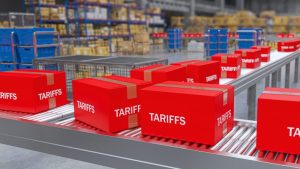LBMC economists and industry advisors unpack how tariffs and tax reform are reshaping manufacturing, maintenance, and capital planning strategies for middle-market companies.
Key Takeaways
- Tariffs are changing how costs are structured: New tariffs, including 50% rates on steel, aluminum, and copper, are driving up costs for manufacturers, disrupting supply chains, and lowering profits, especially in industries dependent on capital and parts.
- Tax reform provides opportunities for offsets: The One Big Beautiful Bill (OBBB) provides incentives such as restored R&D expensing and extending bonus depreciation.
- A proactive strategy can make all the difference: By integrating tariff forecasting, nearshoring, and tax strategies into a cohesive plan, companies can turn unpredictability into a competitive advantage.
With tariff hikes rippling across U.S. supply chains and the sweeping One Big Beautiful Bill (OBBB) tax package now in effect, manufacturers and related RMD (Retail, Manufacturing, and Distribution) industries face one of the most complex financial landscapes in a generation. LBMC’s economists and industry advisors, recognized nationally for their insights into tax strategy, supply chain risk, and manufacturing resilience, are urging business leaders to act now rather than wait for stabilization from Washington.
Tariffs and Tax Reform Collide: Pressure on the Middle Market
The 2025 tariff environment has accelerated uncertainty across manufacturing and industrial sectors:
- Steel and aluminum tariffs doubled to 50%, extending to thousands of downstream products, from construction materials to machinery parts.
- Copper imports now face a 50% rate, straining electronics and industrial component manufacturers.
“A 10% universal “reciprocal tariff” has been applied broadly, driving significant cross-industry cost escalation, said LBMC Chattanooga Managing Director Steve Thomason. “We are also seeing auto parts and industrial machinery tariffs at 25% are disrupting distribution and service networks tied to global supply chains.”
At the same time, the OBBB has introduced major shifts to the tax and investment landscape. Among the most impactful for manufacturers and RMD sectors:
- Full expensing restored for domestic R&D costs, incentivizing onshore innovation.
- 100% bonus depreciation on qualified production property extended through 2029.
- Expanded interest deductibility under Sec. 163(j), improving leverage capacity for capital-intensive industries.
Economist Insight: Finding Opportunity in Disruption
“While the tariff environment introduces real cost and supply chain challenges, the OBBB presents a unique opportunity for manufacturers to offset some of that volatility,” said David Frederick, Economist and Senior Tax Manager of High Net Worth Planning at LBMC. “The key for middle-market businesses is coordination — aligning tariff risk modeling, R&D incentives, and capital structure planning into a cohesive financial strategy. Those who do will be better positioned to maintain competitiveness in an uneven global market.”
Frederick notes that the combined effect of tariffs and tax shifts could widen the profitability gap between proactive and reactive firms. “Margins are being tested on one side, but smart investment timing — particularly in automation, nearshoring, and innovation — can actually turn this disruption into an advantage,” he added.
Where Tariffs Hit Hardest: Manufacturing Sectors
The industries most affected include:
- Advanced manufacturing and precision components, where copper and steel price surges are compressing margins.
- Maintenance, repair, and distribution firms managing parts-intensive supply chains vulnerable to tariff volatility.
- Industrial and construction equipment providers, facing longer lead times and increased capital requirements.
- Private-equity-backed manufacturing platforms, where valuations now hinge on tariff-adjusted cost structures.
Middle-market companies — particularly those in the $25M–$500M range — face amplified exposure due to limited sourcing redundancy and leaner working capital buffers.
Strategic Imperatives for CEOs and CFOs
LBMC advisors highlight four immediate priorities for manufacturing leaders:
- Embed tariff forecasting into financial modeling — include scenario planning for variable rates through 2026.
- Reassess global sourcing and consider nearshoring where cost parity has emerged.
- Leverage OBBB incentives strategically, aligning R&D and capital investment cycles to offset tariff drag.
- Revisit valuations and due diligence models — ensuring M&A and financing assumptions account for new cost realities.
Be Ready for Tariff and Tax Shifts
Ready to turn disruption into opportunity? LBMC’s manufacturing and tax experts help middle-market companies adapt to rising tariffs and changing tax laws. We offer tailored solutions that safeguard margins and set your firm up for success. These include improving your supply chain strategy and getting the most out of your R&D and depreciation incentives. Get in touch to make a plan that fits your goals.
For more about how your company can thrive amid changing tariffs and tax laws, reach out to Steve Thomason, steve.thomason@lbmc.com or David Frederick, david.frederick@lbmc.com.
To learn more about how LBMC can help manufacturing and distribution clients, visit this page.

